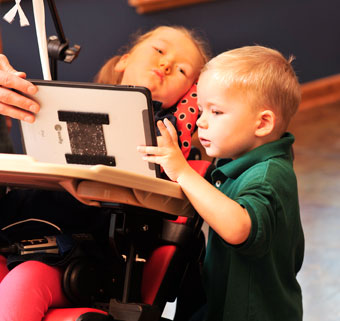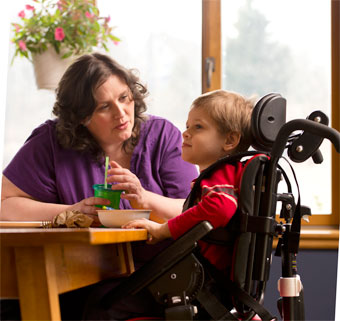 Wheelchair seating and positioning is a frequent source of frustration for parents. I often hear that the wheelchair just doesn’t work well in the home. It is too low to use at the table for meals or homework but it sits too tall for their child to be at the same height as their friends. Or I hear complaints about maneuverability in the home. But perhaps the most important complaint I hear is this: “Why does my child have to sit in the same chair all day, with no opportunities for active sitting?” I love this one, because there’s a huge difference between active and passive sitting and parents instinctively know this.
Wheelchair seating and positioning is a frequent source of frustration for parents. I often hear that the wheelchair just doesn’t work well in the home. It is too low to use at the table for meals or homework but it sits too tall for their child to be at the same height as their friends. Or I hear complaints about maneuverability in the home. But perhaps the most important complaint I hear is this: “Why does my child have to sit in the same chair all day, with no opportunities for active sitting?” I love this one, because there’s a huge difference between active and passive sitting and parents instinctively know this.
I love these questions, and I always tell parents they have other options and they should pursue them. My best suggestion is to supplement your child’s seating options with an activity chair in the home. The benefits are numerous.

For one, adaptive seating systems like the Rifton Activity Chair are made with quick adjustability in mind. Without tools and in a matter of seconds you can make adjustments to tilt, recline, and height. This allows the child to have their needs and postural abilities accommodated throughout the day. The Hi-Lo base makes adaptive seating extremely versatile. This allows the seat to be raised and lowered to meet positioning needs at a variety of heights. The chair can be raised to table height for homework and family meals and then quickly lowered to the floor so the child can join his friends for games and other social interaction and eye level.. This provides a sense of belonging and inclusiveness that may not be possible in the wheelchair and, having the feet on the floor provides the perfect opportunity to work on transfer skills, standing, pivoting and sitting.
We instinctively know—parents in particular—that placing our child at eye level with her peers will improve her social development and psychological well-being. It’s up to us as clinicians to support parents in finding alternatives, and to offer our clients—the children—the opportunities and choices that become available with active seating.
Back to Top